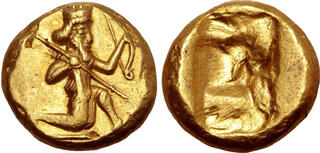| Roma Numismatics Ltd > Auction XXX | Auction date: 21 March 2024 |
| Lot number: 281 Price realized: 4,000 GBP (Approx. 5,067 USD / 4,665 EUR) Note: Prices do not include buyer's fees. | Show similar lots on CoinArchives Find similar lots in upcoming auctions on |
| Lot description: Persia, Achaemenid Empire AV Daric. Time of Darios I to Xerxes II. Sardes, circa 485-420 BC. Persian Great King or hero, wearing kidaris and kandys, in kneeling-running stance to right on exergual line, holding apple-tipped spear and strung bow; quiver over shoulder / Rectangular incuse punch. Carradice Type IIIb, Group A/B (pl. XIII, 27); Meadows, Administration 321; BMC Arabia pl. XXIV, 26; Sunrise 24; cf. GRPC Lydia G61. 8.39g, 15mm. Extremely Fine; lustrous metal with light red toning, well centred and struck for the type - a wonderful example. Ex Jonathan P. Rosen Collection, Classical Numismatic Group, Auction 114, 13 May 2020, lot 431 (hammer: USD 3,500). The ancient Greeks themselves believed that the term 'dareikos' was derived from the name of Darius the Great, an assessment that many modern scholars agree with. Others however have generally supposed that the Greek term can be traced back to old Persian 'dari' (golden) and that it was first associated with the name of Darius only in later folk etymology. Both suppositions may be equally valid. While the Persians had not traditionally used coinage, Cyrus the Great had introduced it to the Persian empire with the conquest of the Lydian Kingdom in 546 BC. The Lydian coinage series featuring a confronted lion and bull type was continued at first, but under the reign of the third Great King, Darios I, the Lydian gold stater was converted into a type bearing the stylised image of the Persian ruler or a hero, a type which would last with little modification until the conquest of Persia by Alexander in the 330s BC. One of the principal motivating factors behind this institution of an official Persian currency was the requirement to pay Greek mercenaries, who were accustomed to receiving payment in coinage, or for official use as bribes and subsidies. Indeed, nothing demonstrates the power of the gold daric more succinctly than when Sparta was waging an increasingly successful war led by Agesilaos II against Persia in Asia Minor (398-395 BC). Unable to defeat the Spartan army, the satrap Pharnabazos sent an Asiatic Greek by the name of Timocrates of Rhodes to distribute ten thousand gold darics in the major cities of mainland Greece and thus incite them to war against Sparta. Athens, Thebes, Corinth and Argos quickly entered into conflict with Sparta, precipitating a messenger to be sent to Agesilaos ordering him to return to Greece. The recall was a bitter disappointment to Agesilaos, who wryly observed that "but for ten thousand 'archers', he would have vanquished all Asia." Estimate: 3500 GBP |  |


